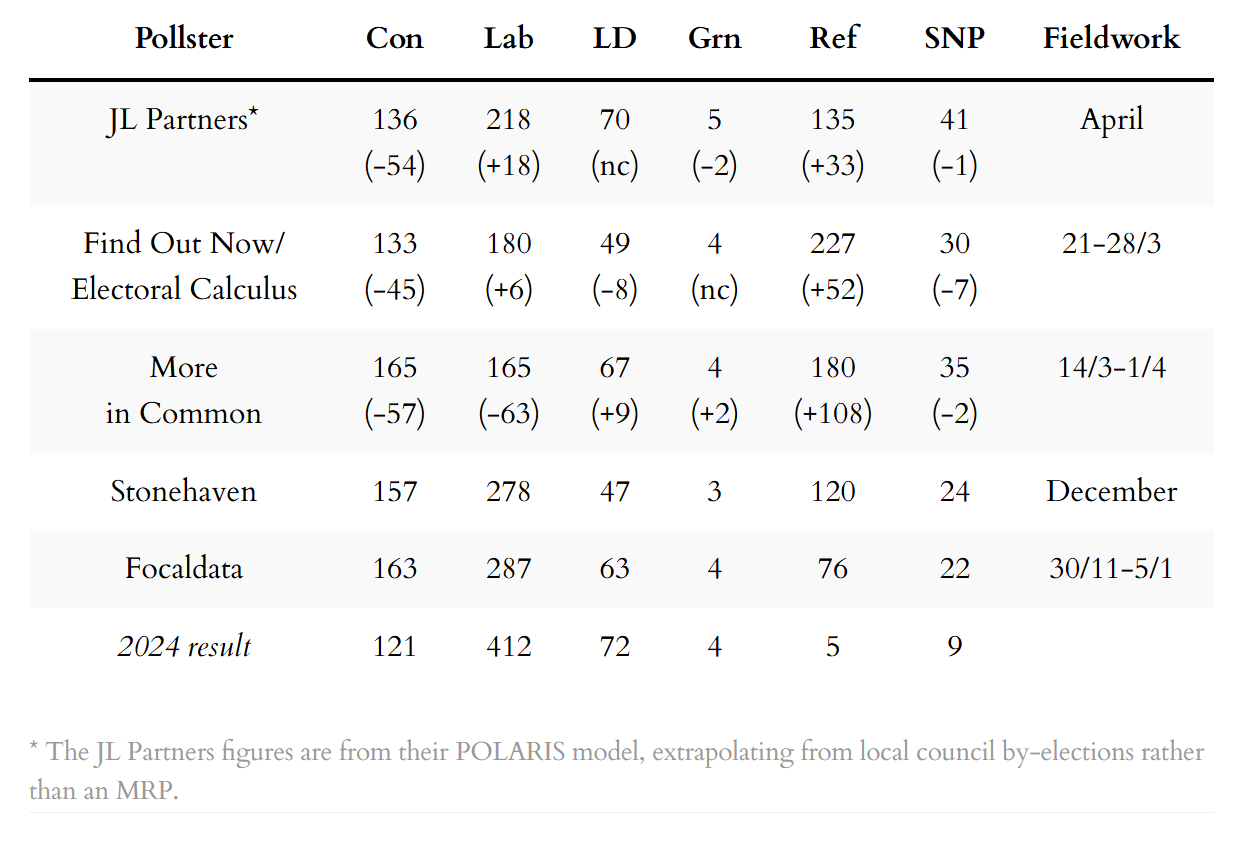Welcome to the 157th edition of The Week in Polls (TWIP) which goes back in time to the earliest national political polls in Britain, showing how unpopularity and failure do not always go hand in hand. Yes, it is time to graph Neville Chamberlain’s approval ratings in 1938-40.
Next week though it will be right back into the 21st century with talk of national vote shares and local elections.
Then it is a summary of the latest national voting intention polls and a round-up of party leader ratings. With a bonus new table this week: I am starting to include the latest seat totals from MRPs and other similar projections.
Those are followed by, for paid-for subscribers, 10 insights from the last week’s polling and analysis.
This time, those ten include what the British public think of workplace DEI (Diversity, Equity, and Inclusion) initiatives.
If you are not yet a paid-for subscriber, you can sign up for a free trial now to read that and all the other stories:
Before we get to that the latest of my reviews of books about the 2024 general election is out, and this time it is a book packed full of polling information:
And with that, on with the show.
Want to know more about political polling? Get my book Polling UnPacked: the history, uses and abuses of political opinion polling.
Prime Minister approval ratings for Neville Chamberlain
The story of Neville Chamberlain, his policy of appeasement of Hitler and his replacement by Winston Churchill after war broke out is well known.
There is much that has been written about all this, and no doubt much more to come. Partly because of the vast tragic scale of the denouement for the policy of appeasement. Partly because evaluating the policy requires evaluating also hypothetical alternatives about which we can never be sure. Partly too because the records left to us give conflicting accounts of the key period when Chamberlain went from 10 Downing Street, Churchill arrived and the government decided to fight rather than sue for peace.
One thing about the that particular sequence have always intrigued me. While from a big picture perspective Winston Churchill succeeding Neville Chamberlain was a very understandable outcome, it is usually overlooked quite how baffling the exact circumstances were. Chamberlain’s demise and Churchill’s ascent were triggered by the failure of the invasion of Norway. And who had been the chief instigator, promoter, cheerleader and executioner of that policy? Winston Churchill.
To have your major policy of the moment disintegrate into disaster and yet see that very disaster make you Prime Minister is a political Houdini act that I struggle to think of parallels for.
But none of that is polling. (Though if you are interested, I would recommend Six Minutes in May: How Churchill Unexpectedly Became Prime Minister.)
So getting back on topic, these events coincided with the commencement of political polling in the UK, with the first Prime Minister ratings and by-election polls in 1938 and the first national voting intention data in 1939, all from Gallup.1
The accounts more sympathetic to Chamberlain point out how strongly the public supported appeasement at the time. What do the polls tell us?
Having recently added this data to Pollbase, I can now graph the Prime Ministerial ratings changed in the polls during 1938, 1939 and 1940.
All the data is from Gallup, and where necessary the percentages have been (re)calculated to include don’t knows as that is the convention for presenting leadership polling.2 It also appears3 that Gallup changed its question wording - from ‘are you satisfied…’ to ‘do you approve or disapprove…’ - in late 1940. As even small differences in the wording of leader ratings questions can produce systematic and noticeable differences in the results, the questions are split out into different lines on the graph.
1940 - the year of the fall of France and the Battle of Britain - saw a British Prime Minister score net +21 in March, fall to net -27 in May and then their successor hit net +81 in July.
Quite the polling rollercoaster (and kudos to Anthony Wells for correctly guessing the year when I posted just the monthly scores on social media).
We do not know (yet) the exact polling dates of the May 1940 Gallup poll. But it is notable that it was only Germany’s dramatically successful invasion of France combined with the stumbled in the attempted British/French invasion of Norway that had seen Chamberlain’s ratings tumble.
The Munich Agreement (September 1938), its subsequent breach by Hitler with the seizure of the rest of Czechoslovakia (March 1939) and the invasion of Poland (September 1939) had all left Chamberlain with high public ratings.
As with Churchill, seeing a signature policy fail badly did not - at least at first - dent Chamberlain’s public political standing. For Chamberlain, it took a second disaster - on the battlefield in the Ardennes as Germany swiftly advanced deep into France - for unpopularity to catch up.
Failure and unpopularity do not always go neatly hand in hand.
Voting intentions and leadership ratings
Here are the latest national general election voting intention polls, sorted by fieldwork dates.
The figures for the Liberal Democrats this week are less excitable for the party’s supporters than last week, though the fact that 14% with YouGov or More in Common can now count as slightly disappointing itself shows the party’s previous rise in the polls.
Next, the latest seat projections from MRP models and similar, also sorted by fieldwork dates:
Rob Ford has a good thread on the limitations of such seat projections this far out from a general election.
Finally, a summary of the the leadership ratings, sorted by name of pollster:
For more details, and updates during the week as each new poll comes out, see my regularly updated tables here and follow The Week in Polls on Bluesky.
For the historic figures, including Parliamentary by-election polls, see PollBase.
Catch-up: the previous two editions
My privacy policy and related legal information is available here. Links to purchase books online are usually affiliate links which pay a commission for each sale. For content from YouGov the copyright information is: “YouGov Plc, 2018, © All rights reserved”.4
Quotes from people’s social media messages sometimes include small edits for punctuation and other clarity.
Please note that if you are subscribed to other email lists of mine, unsubscribing from this list will not automatically remove you from the other lists. If you wish to be removed from all lists, simply hit reply and let me know.
A different way of looking at voting intention data, and other polling news
The following 10 findings from the most recent polls and analysis are for paying subscribers only, but you can sign up for a free trial to read them straight away.
The way in which standard opinion poll crosstabs present some, but only some,
Keep reading with a 7-day free trial
Subscribe to The Week in Polls to keep reading this post and get 7 days of free access to the full post archives.









